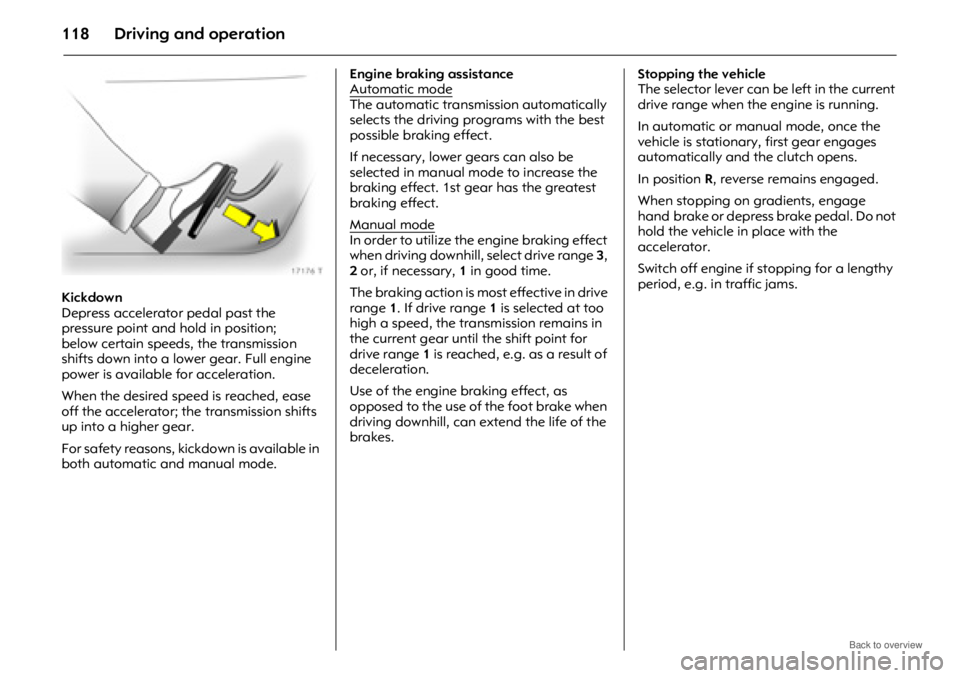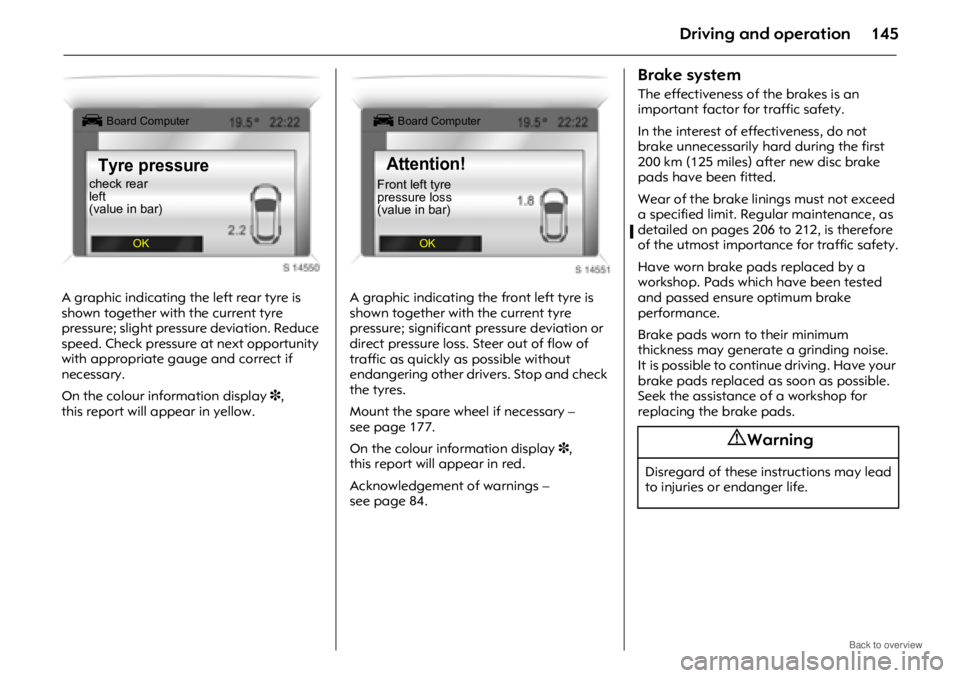brakes OPEL ANTARA 2009 Owners Manual
[x] Cancel search | Manufacturer: OPEL, Model Year: 2009, Model line: ANTARA, Model: OPEL ANTARA 2009Pages: 234, PDF Size: 3.01 MB
Page 19 of 234

In brief19
Starting the engine:
Manual transmission in neutral,
Depress clutch and foot brake,
Automatic transmission in P or N,
Do not accelerate
Petrol engines:
TurnkeytoSTARTand release it
Diesel engines:
Turn key to ON, when preheating
control indicator N
extinguishes
1), turn key to START
and release it
Key returns automatically to ON position
when released. Start attempts should not last longer than
15 seconds. If engine does not start, wait
10 seconds before repeating starting
procedure.
The increased engine
speed automatically
returns to normal idling speed as the
engine temperature rises.
Drive at a moderate speed, especially in
cold weather, until normal engine
operating temperatures have been
reached.
6 Electronic immobiliser - see page 22,
diesel fuel system - see page 171,
further information - see pages 127, 129,
131.
Releasing the hand brake:
Raise lever slightly,
press release button,
lower lever fully
To reduce operating forces, depress foot
brake at the same time.
Do not drive with hand brake on, to avoid
damage to brakes on the rear wheels. Do
not apply hand brake while vehicle is in
motion or as a substitute for the foot brake.
Drive carefully, economically and with the
environment in mind. While driving, do not
do anything that could distract you.
6 Hand brake - see page 147.
1)Preheating system switches on only if outside
temperature is low.
Page 39 of 234

Seats, interior39
Head restraints
To adjust head restraint height, press
release button, adjust height to suit then
release the button.
Pull head restraint up to raise. Push head
restraint down while pressing the release
button to lower the head restraint. Activ
e head restraints 3In the event of a re
ar-end impact, the
active head restraints automatically tilt
forwards. The head is more effectively
supported by the head restraint and the
danger of hyperextension in the area of the
cervical vertebra is reduced.
Do not attach objects or components that
are not approved for your vehicle to the
head restraints. These affect the protective
effect of the head re straints and can be
propelled through the vehicle in an
uncontrolled manner if the driver brakes
hard or an accident occurs.
Head restraint position
For maximum protection, the middle of the
head restraint should be at eye level. If this
is not possible for extremely tall persons,
set to highest position, and set to lowest
position for extremely small persons.
9 Warning
Disregard can lead to injuries which could
be fatal. Vehicle passengers must be
informed accordingly before moving
away.
Page 96 of 234

Lighting96
Front fog lamps
>
The front fog lamps can only be switched
on when both the ignition and headlamps
are on.
With automatic dipped beam activation 3,
parking lamps and dipped beam come on
simultaneously when the front fog lamps
are switched on.
Follow the regulations of the country in
which you are driving when using front fog
lamps.Fog tail lamp r
The fog tail lamp can only be switched on
when the ignition is on and the light switch
is in position 9, or the front fog lamps are
on and the light switch is in position 8.
With automatic dipped beam activation 3,
parking lamps and dipped beam come on
simultaneously when the fog tail lamp is
switched on.
Reversing lamps
Come on when reverse gear is engaged
and ignition is switched on.
Centre high-mounted stop lamp
Comes on when the brakes are applied,
acting as a third stop lamp, to supplement
the brake lamps.
On = Press button >, >
illuminates in instrument
panel.
Off = Press button > again, >
extinguishes in instrument
panel.
On = Press button r, r
illuminates in instrument
panel.
Off = Press button r again, r
extinguishes in instrument
panel.
Page 118 of 234

Driving and operation118
Kickdown
Depress accelerator pedal past the
pressure point and hold in position;
below certain speeds, the transmission
shifts down into a lower gear. Full engine
power is available for acceleration.
When the desired speed is reached, ease
off the accelerator; the transmission shifts
up into a higher gear.
For safety reasons, kickdown is available in
both automatic and manual mode. Engine braking assistance
Automatic mode
The automatic transmi
ssion automatically
selects the driving programs with the best
possible braking effect.
If necessary, lower gears can also be
selected in manual mo de to increase the
braking effect. 1st gear has the greatest
braking effect.
Manual mode
In order to utilize the engine braking effect
when driving downhill, select drive range 3,
2 or, if necessary, 1 in good time.
The braking action is mo st effective in drive
range 1. If drive range 1 is selected at too
high a speed, the transmission remains in
the current gear until the shift point for
drive range 1 is reached, e.g. as a result of
deceleration.
Use of the engine braking effect, as
opposed to the use of the foot brake when
driving downhill, can ex tend the life of the
brakes. Stopping the vehicle
The selector lever can be
left in the current
drive range when the engine is running.
In automatic or manual mode, once the
vehicle is stationary, first gear engages
automatically and the clutch opens.
In position R, reverse remains engaged.
When stopping on gradients, engage
hand brake or depress brake pedal. Do not
hold the vehicle in place with the
accelerator.
Switch off engine if stopping for a lengthy
period, e.g. in traffic jams.
Page 122 of 234

Driving and operation122
Always exercise caution when in slippery
conditions (caused by sand, gravel, water,
snow or ice on the road), in order to
maintain vehicle control.
Use the accelerator to control the vehicle -
keep brake pedal use to a minimum.
zDo not slip the clutch.
z Do not spin the wheels.
z Do not make exaggerated or jerky
steering movements.
Driving a vehicle in snow and ice should be
undertaken with extreme caution:
z Select a gear suitable for the conditions.
z Start the vehicle moving with minimal
engine revs, low gear and combined
clutch and accelerator control.
z Change to a higher gear as quickly as
possible, to keep the engine revs low.
z With automatic transmission 3, select
drive range D and press button n, to
activate the Winter program. Off-road driving
During off-road drivin
g, you will encounter
a variety of driving conditions and
circumstances too numerous to list here.
Always use good judgement and common
sense. If you feel uncomfortable about
tackling a given situation, do not attempt
it.
Avoid protruding objects (such as rocks or
tree stumps) that may damage the
underbody and tyres of your vehicle.
Test the brakes after operating in mud, to
clear excess mud from the braking
surfaces.
Gripping the steering wheel
Terrain conditions can cause rapid and
unexpected movement in the steering,
especially rough terrain. Preparation
The duration, distance and conditions of
the off-road activity determine the extent
of the preparation th
at is required. The
following are given as guidelines.
Know the area where you will be driving,
either by inspection or from terrain maps.
Decide your route in advance and ensure
that it is a vehicular right of way
1).
Make a thorough check of the vehicle.
Check the following:
z Oil, water, fuel, brake and clutch fluid
levels,
z Drive belts,
z Windscreen wipers and washer system,
z Lamps.
Maintenance - see pages 126, 206.
9 Warning
Be ready to deal with these movements
by having a firm grip on the outer rim of
the steering wheel with the thumbs
outside the spokes, to guard against
injury from kickback.
1)Observe national regulations.
Page 124 of 234

Driving and operation124
The ground clearance, ramp angle, angle
of approach and departure and wading
depth need to be considered, especially in
hilly conditions and when wading, to
prevent the vehicle becoming stuck and
possibly damaged.
Technical data - see page 215. Driving through water
Do not exceed th
e maximum wading
depth.
Check the depth of water: choose the
lowest entry and departure angles before
entering.
Maintain a steady engine speed, to help
prevent water from entering the exhaust
system, but do not exceed 5 km/h (3 mph),
to avoid splashing the water.
Drive with the flow wherever possible, not
against it. If you have to drive against the
flow, try to drive at an angle to it, so that
the leading corner of the vehicle will help
deflect water from the engine
compartment.
Avoid splashing the water - if the ignition
system becomes wet, the engine may stall. Avoid water entering the air intake system.
Test the brakes after leaving the water -
wet brakes are less effective than dry ones.
Perform the service operations for wading,
involving checks for water contamination,
at the earliest opportunity.
Service checks after wading -
see page 126.
9 Warning
If water enters the air intake system,
engine seizure with severe costly damage
may result.
Page 126 of 234

Driving and operation126
Maintenance
Certain maintenance operations, e.g.
changes of engine oil, oil filter, air cleaner
element and brake pads, are required
more frequently for severe operating
conditions, e.g. driving on unsurfaced
roads, during thick dust or mud
accumulation, etc.
If the vehicle is driven off-road to a great
extent, the chassis will need regular
inspection.
Your Opel Partner will inform you which
additional service is required between the
normal service intervals, after
consideration of the specific operating
conditions of your vehicle.
Further information - see page 206.
Service checks after wading
After wading, check for the ingress of water
into the following:
zBrake fluid reservoir,
z Air cleaner element,
z Engine,
z Transmission,
z Axles,
z Interior of vehicle.
Renew any lubricating oil or hydraulic fluid
that has a milky appearance, indicating
contamination with water. All Wheel Drive summary
Do
z
Check fuel and tyres, water and oil levels
before venturing off-road.
z Survey on foot before driving off-road,
especially when traversing hillsides,
wading, driving in deep snow and over
ridges.
z Select the correct gear for the conditions.
z Use the engine’s power of acceleration
and deceleration with the correct gear,
to control the vehicle.
z Keep a firm grip on the outer rim of the
steering wheel - keep your thumbs away
from the spokes.
z Drive carefully and be prepared for
emergencies.
z Drive slower under crosswind conditions.
z Approach obstacles and conditions
off-road at the correct angles and with
sufficient momentum to negotiate the
obstacle, but do not put undue strain on
the vehicle.
z Use caution - if you are not sure, do not
do it. Don’tz
Do not venture off-road unless you are
certain that the conditions are capable
of being negotiated safely by you and
your vehicle.
z Do not take unnecessary risks.
z Do not use the brakes excessively, to
maintain steering control.
z Do not change gear on difficult terrain -
depressing the clutch may cause the
vehicle to stop because of drag on the
wheels - or accelerate backwards or
forwards when on a hill.
z Do not ride or slip the clutch.
z Do not spin the wheels if stuck in mud,
sand or snow - they will only dig in
deeper.
z Do not drive at an excessive speed,
especially into corners. Your All Wheel
Drive vehicle has a higher centre of
gravity than conventional vehicles.
Sudden changes of direction can lead to
loss of control.
Page 145 of 234

Driving and operation145
A graphic indicating the left rear tyre is
shown together with the current tyre
pressure; slight pressure deviation. Reduce
speed. Check pressure at next opportunity
with appropriate gauge and correct if
necessary.
On the colour information display 3,
this report will appear in yellow. A graphic indicating the front left tyre is
shown together with the current tyre
pressure; significant pressure deviation or
direct pressure loss. Steer out of flow of
traffic as quickly as possible without
endangering other drivers. Stop and check
the tyres.
Mount the spare wheel if necessary –
see page 177.
On the colour information display
3,
this report will appear in red.
Acknowledgement of warnings –
see page 84.
Brake system
The effectiveness of the brakes is an
important factor for traffic safety.
In the interest of effectiveness, do not
brake unnecessarily hard during the first
200 km (125 miles) after new disc brake
pads have been fitted.
Wear of the brake linings must not exceed
a specified limit. Regular maintenance, as
detailed on pages 206 to 212, is therefore
of the utmost importance for traffic safety.
Have worn brake pads replaced by a
workshop. Pads which have been tested
and passed ensure optimum brake
performance.
Brake pads worn to their minimum
thickness may generate a grinding noise.
It is possible to continue driving. Have your
brake pads replaced as soon as possible.
Seek the assistance of a workshop for
replacing the brake pads.
Ü Board Computer
Tyre pressure
OK
check rear
left
(value in bar)
Ü Board Computer
Attention!
OK
Front left tyre
pressure loss
(value in bar)
9 Warning
Disregard of these instructions may lead
to injuries or endanger life.
Page 146 of 234

Driving and operation146
Brake assist
Rapid powerful application of the brake
pedal automatically applies maximum
brake force amplification to achieve the
shortest possible braking distance under
full braking (brake assist).
Maintain steady pressure on the brake
pedal for as long as full-on braking is to
continue. When the brake pedal is
released, the maximum brake force
amplification is taken away.Foot brake
The brake system comprises two separate
brake circuits.
If one brake circuit should fail, the vehicle
can still be braked with the second
remaining circuit.
If this happens, the brake pedal must be
fully depressed with greater pedal
pressure. The distance required for braking
will be greater.
If, at any time during driving, the brake
pedal can be depressed further than
normal, the vehicle repeatedly pulls to one
side under braking or brake noise is heard,
consult a workshop.
In order to utilise the full pedal travel,
particularly in the event of a brake circuit
fault, there must be no mats in the area of
the pedals - see page 128.
With the engine stopped, the brake servo
assistance is discontinued after the brake
pedal has been depressed once or twice.
The braking effect is not reduced, but
increased foot pressure will be necessary.
Take extra care when the vehicle is being
towed.
Check the brake lamps before starting out
on a journey. Shortly after the start of each
journey, the brake system should be tested
for its effectiveness at low speed and
without inconveniencing other road users,
especially if the brakes are wet, e.g. after
washing your vehicle.
Excessive braking when going downhill can
cause brakes to temporarily overheat. Shift
to a lower gear rather than continuously
applying brakes.
The brake fluid level should be checked
regularly - see page 196.
Page 147 of 234

Driving and operation147
Hand brake
Always apply hand brake firmly. On slopes,
apply the hand brake as firmly as possible.
The mechanical hand brake acts on the
brakes on the rear wheels. It engages
automatically when applied.
To release the hand brake, press and hold
the button, pull the lever up slightly and
lower lever while holding the button in.
To reduce the operating forces of the
hand brake, depress the foot brake at the
same time. Control indicator
4 for brake system
Illuminates when ignition is switched on.
Extinguishes after engine is started.
Illuminates if hand brake is applied and/or
fluid level for brake hydraulics is too low.
Brake fluid level - see page 196. If the control indicator stays lit, the brakes
do not operate as normal or leaks are
found in the brake system, do not attempt
to drive the vehicle. Have the vehicle towed
to a workshop for inspection and repair.
If the control indicator does not illuminate
when the ignition is switched on or when
the hand brake is applied (with ignition
on), stop and consult a workshop.
9 Warning
If it illuminates when the hand brake is
not applied: stop vehi
cle, interrupt your
journey immediately.
Check brake fluid level and top-up if
necessary before consulting a workshop.
Have cause of brake fluid loss remedied.